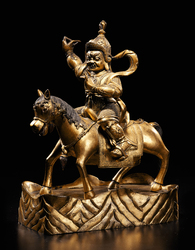
Buddhist Worldly Protector: Tsangpa Karpo Main Page
Tsangpa Karpo MasterworksSubjects, Topics & Types:
- Description (below)
- Study Topics:
--- Appearance & Identification
--- Origins & Relationships
--- Chronology & Regions of Art
- Worldly Protector Deities
- Confusions: Chingkarwa, Nyipangse
- Others...
Videos:
- Tsangpa Karpo
- Worldly Protectors
- Protector Deity Videos
Identifying Characteristics:
- Warrior Appearance (drala)
- White in colour
- White turban
- White Conch head ornament
- Riding a horse
Additional Traits & Attributes:
- Three eyes or two eyes
- Appearance: peaceful, semi-peaceful, wrathful
- Right Hand: sword, riding crop, spear
- Left Hand: lasso, bowl of jewels, mongoose, flag, spear
- Horse mount: white, brown, black
- White bird overhead
- White dog
Appearance & Identification:
Tsangpa Karpo (White Brahma) is the name Tibetans use when referring to the Hindu god Brahma. However, Tsangpa is also the name of a Tibetan worldly god who functions as a protector deity for Tibetan Buddhism and more specifically, in modern times, for the Gelug tradition.
There does not yet appear to be an iconographic consistency with many of the paintings depicting Tsangpa Karpo. There are only a few characteristics and attributes which are used to identify Tsangpa when an inscription is lacking.
The most repeated and recognizable characteristics for Tsangpa Karpo are the white conch shell situated on the top of the head, the overall Warrior Appearance and the white body colour. All of the other attributes can vary individually or in their combinations. A figure that is very similar in appearance and sometimes confused for Tsangpa is Chingkarwa who is sometimes said to be an attendant figure.
Origins & Relationships:
There will be one or more origin myths for the god Tsangpa Karpo depending on the geographic region and possibly the narrating religious tradition. It is likely that he originated regionally and was associated with a specific valley or a mountain. Within the pantheon of worldly deities he is classified generally as a 'lha' meaning deva or god. Some ritual texts regard him as a 'gyalpo' referring to a 'king' spirit such as Pehar and Dorje Shugden. Tsangpa also plays a role in the epic tales and life story of Ling Gesar.
Some texts refer to Tsangpa as an emanation of Pehar Gyalpo while others refer to him as the peaceful form of Dorje Setrab. The Bon religion also draws a relationship between Nyipangse and Tsangpa. Tibetan Buddhist worldly deities became especially popular in the 17th century during the time of the great 5th Dalai Lama. The vast majority of known paintings and sculpture were created after this time. An important early ritual text was composed by the 3rd Panchen Lama, Palden Yeshe (1738-1780), in the 18th century.
Chronology & Regions of the Art:
All of the art depicting Tsangpa on the HAR website appears to belong to the Gelug tradition of Tibetan Buddhism. Tsangpa is not typically found in the Sakya or Kagyu ritual protector deity traditions or represented in art as a primary or secondary figure.
The earliest known painting is likely to be a black ground composition, HAR #853, dated to the late 17th or early 18th century, Lhasa, Central Tibet, with an inscription on the reverse with the name of Wangchen Lerab Tsal - a Nyingma Terton of the 18th century (exact dates unknown). Another potential late 18th century painting from Central Tibet is HAR #60692. Composition #34855, in a very clear Shigatse painting style, was a gift to the Qianlong Emperor by the 3rd Panchen Lama in the late 18th century. The painting currently resides in the Palace Museum in Beijing.
The three Central Tibetan compositions dated to the 18th century confirm that Tsangpa Karpo was a notable worldly protector deity of the Gelug tradition at that time. There are two representative Eastern Tibetan compositions with all of the remaining paintings appearing to be Mongolian and from the late 19th and early 20th centuries.
Paintings - Geographic Locations:
- Central Tibet: HAR #853, 60692, 16548, 34855, 58064
- Eastern Tibet: 77193, 55040
- Mongolia: 1110, 49030, 49071, 50105, 50529, 50562, 50805, 94387, 101607
A single sculpture is identified as Tsangpa, HAR #13405, having a conch shell adorning the top of the helmet. It is possible that one or more of the attendant horsemen to Vaishravana Riding a Lion may also be decorated with a conch shell.
Database Search: All Paintings
Jeff Watt 1-2016 [updated 1-2022]
Copyright © 2024
Himalayan Art Resources Inc.











